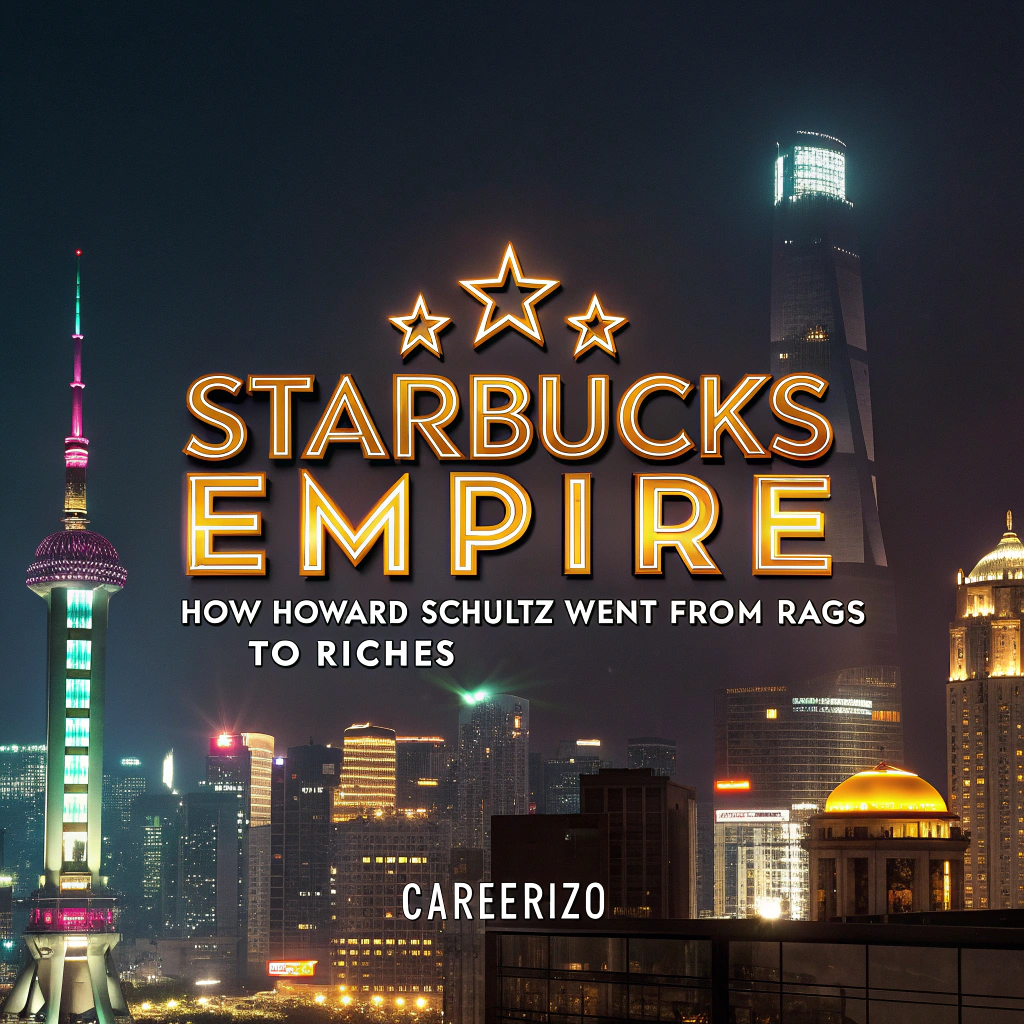Starbucks Empire How Howard Schultz Went From Rags to Riches careerizo
Howard Schultz’s life shows how will & new thoughts work. He was born in a poor home in Brooklyn. His way to be the head of a big coffee firm was not clear. Yet, his tale is one of great win. He made Starbucks a known name.
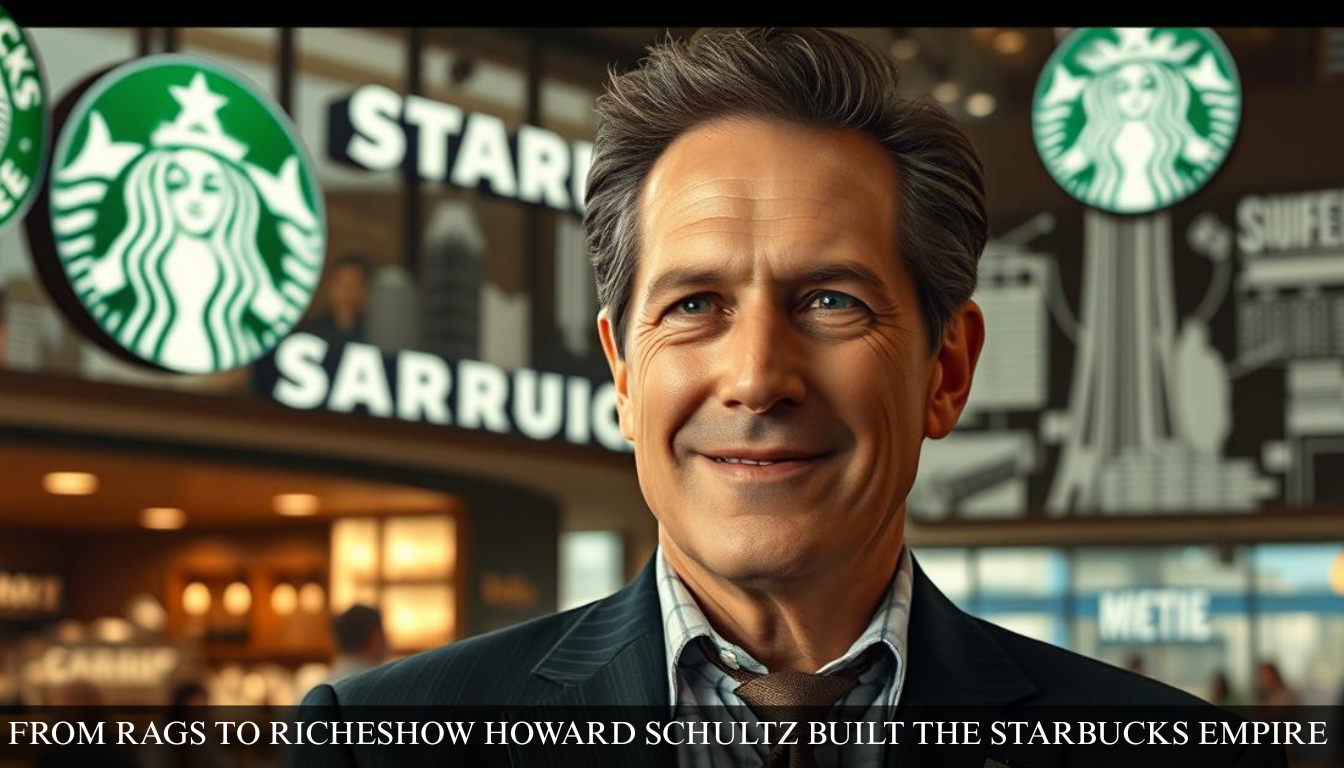
Under Schultz’s leadership, Starbucks expanded from a few local stores to a global brand, revolutionizing the coffee shop experience. His vision for a company that not only served coffee but also became a community hub resonated with millions.
Key Takeaways
- Howard Schultz’s humble beginnings and his rise to becoming a successful entrepreneur.
- The transformation of Starbucks into a global coffee powerhouse under Schultz’s leadership.
- The innovative strategies implemented by Schultz to revolutionize the coffee shop experience.
- The impact of Schultz’s vision on creating a community centric brand.
- The global expansion of Starbucks and its effects on the coffee industry.
The Humble Beginnings of Howard Schultz
Growing up in Brooklyn’s housing projects, Howard Schultz faced numerous challenges that shaped his determination. His early life was a testament to the struggles many families face, and it laid the groundwork for his future success.
Growing Up in Brooklyn’s Housing Projects
Schultz’s young years were hard. He had little cash at home. He learned a lot from this. He grew strong & knew hard work was key. He said, “I was in a poor home in Brooklyn. Not much cash. My dad drove trucks. We got help once too.”
Family Financial Struggles and Early Life Lessons
The Schultz kin had hard times with money. At times, they used welfare. These hard times gave
Howard Schultz a strong drive to work & do better. His folks’ fights & no backup taught him to be smart & set on his goals.
The Pivotal Moment: His Father’s Work Injury
A key time came when Schultz’s dad got hurt at work. This left the home with no set pay. This hit hard for Schultz. He saw the need for help & rights for work folks. He said, “My dad’s hurt was a big deal… it made me see how frail life is & how key pride in work is.”
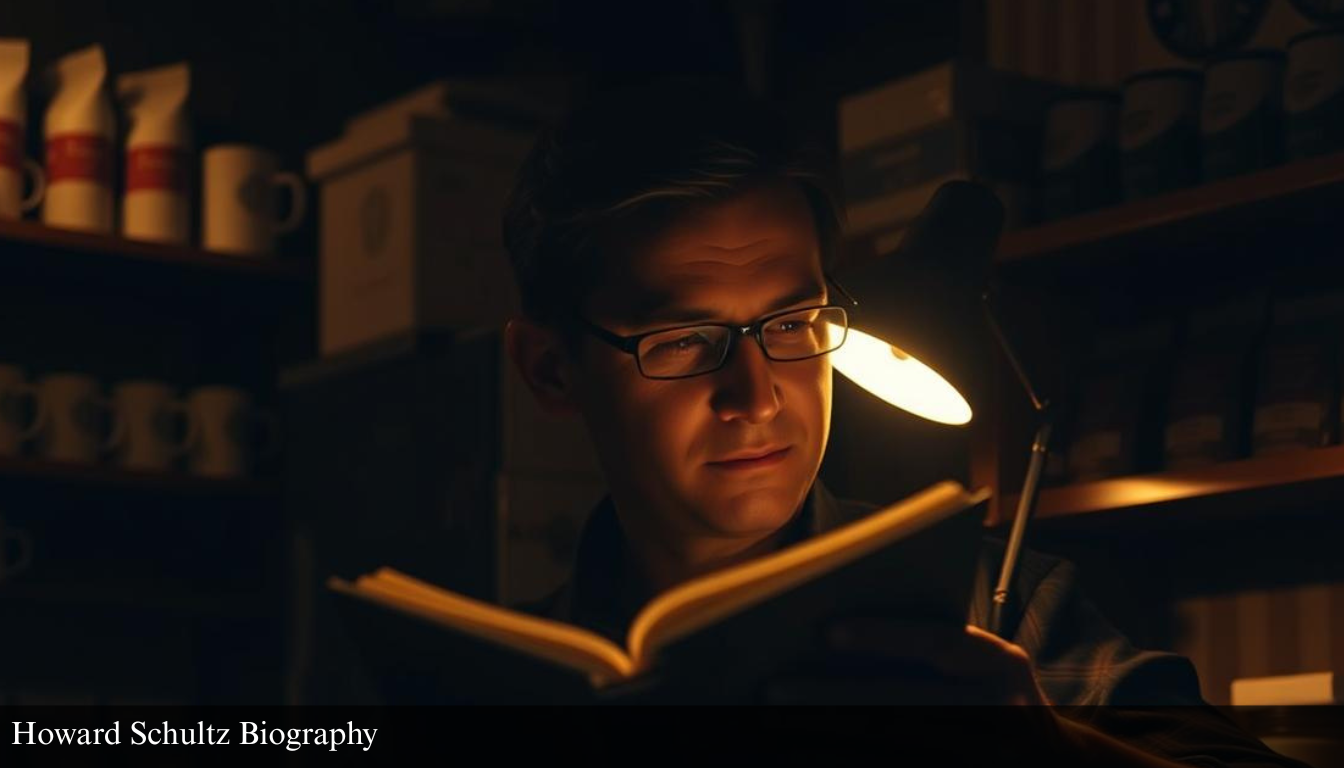
These early life experiences not only shaped Schultz’s character but also influenced his later business decisions, particularly his commitment to employee welfare at Starbucks.
Educational Journey and First Career Steps
Schultz’s early life and education laid the groundwork for his future success in the business world. His academic achievements were marked by a significant milestone when he attended Northern Michigan University on a sports scholarship.
Northern Michigan University on Sports Scholarship
At Northern Michigan University, Schultz not only excelled in sports but also developed a keen interest in business and sales. This period was crucial in shaping his understanding of the importance of hard work and strategic planning.
Sales Career Development at Xerox and Hammarplast
After school, Schultz got a job at Xerox. He grew his sales skills there. It was a tough place to work. He then went to Hammarplast. It is a firm from Sweden. He got even better at sales there. All this work helped him learn how to do biz well.
Building the Foundation of Business Acumen
Through his roles at Xerox and Hammarplast, Schultz gained valuable insights into sales strategies and customer relations. These early career steps were foundational in his entrepreneurship journey, teaching him the importance of innovation and customer satisfaction in driving business expansion.
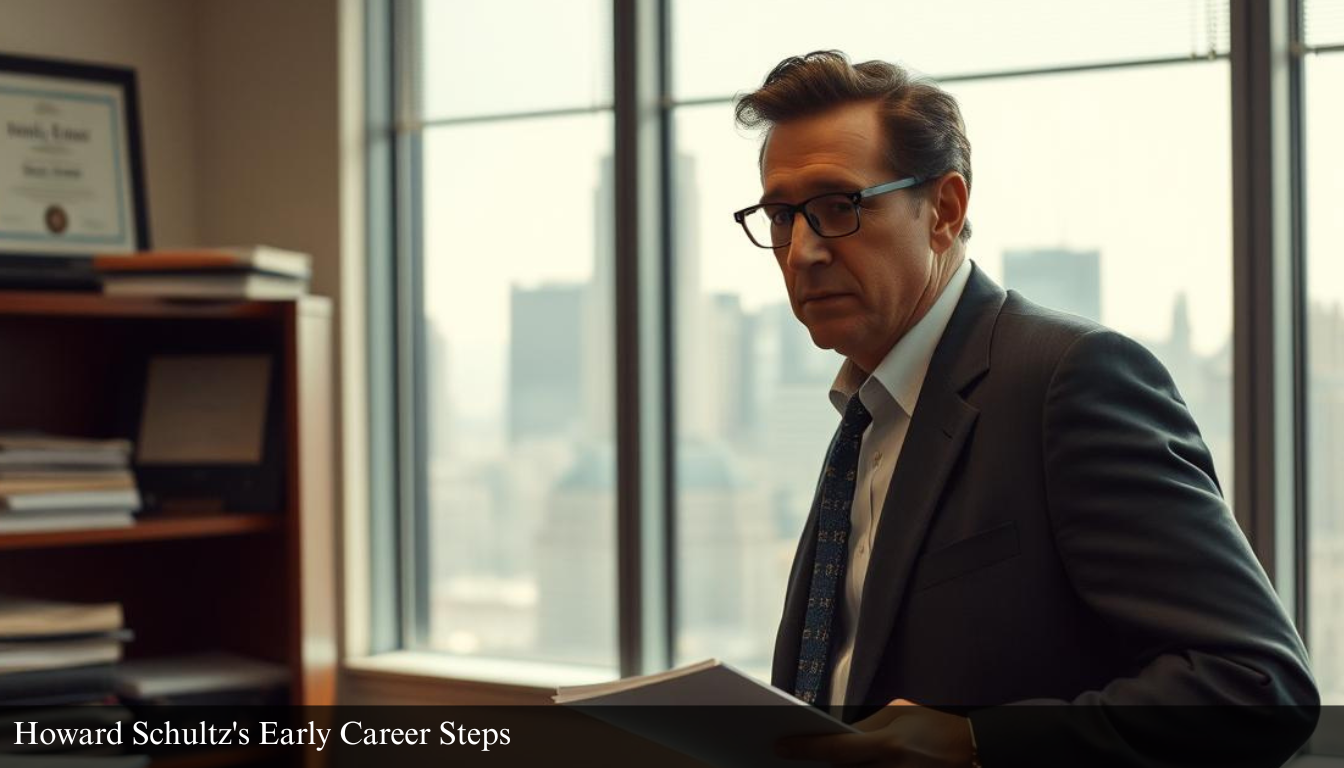
The Fateful Discovery of Starbucks
In 1981, Howard Schultz went into the first Starbucks in Seattle. He did not know how big it would be for his life. At that time, Starbucks was a small shop. They sold top, rate coffee beans & gear. Schultz loved the firm’s love for coffee. He liked their cool way of selling coffee.
First Visit to the Original Seattle Store in 1981
Schultz’s first trip to Starbucks was not just a quick stop. It was the start of a path that would change the coffee world for good. He liked how much the staff knew. He dug their zest too. He saw how the shop stuck to good coffee. This first meet lit up Schultz’s will to know the firm. He saw its chance to grow big.
The Coffee Epiphany in Milan, Italy
In 1983, Schultz went to Milan, Italy. He had a big wake, up call with coffee. He loved the coffee world in Italy. The coffee shops were where folks met. He saw a rich feel & a bond in them. This shaped his big idea for Starbucks.
Envisioning the Italian Coffeehouse Experience in America
Schultz aimed to bring the Italian coffee shop vibe to the US. He thought of it as a “third place” aside from home & work. Here, folks could meet, chill, & sip top, notch coffee. This dream did shape what Starbucks became. It changed how we see coffee shops in the US. What he thought of included:
- Crafting a unique customer experience
- Creating a welcoming atmosphere
- Serving high-quality coffee
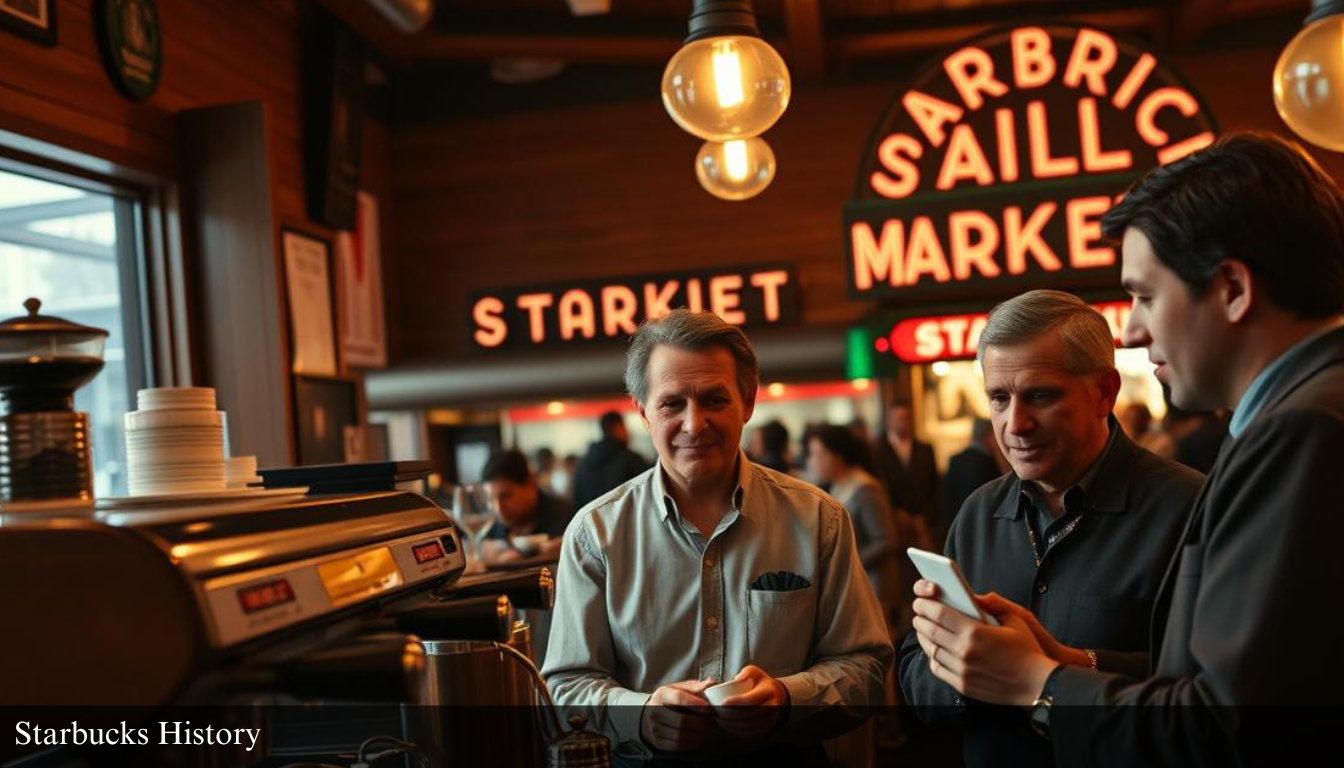
Schultz’s experiences in Seattle and Milan laid the groundwork for his future involvement with Starbucks, ultimately transforming the company into the global coffee empire it is today.
From Employee to Visionary: Joining Starbucks
The opportunity to join Starbucks marked the beginning of Schultz’s transformative journey. In 1982, Schultz was hired as the director of marketing and operations, a role that allowed him to bring his innovative ideas to the company.
Convincing the Founders to Hire Him as Director of Marketing
Schultz was drawn to Starbucks because of its commitment to quality coffee. He convinced the founders of his value as a marketing professional, showcasing his ability to elevate the brand.
Clash of Visions with Original Owners
However, Schultz soon found himself at odds with the original owners over the direction of the company. His vision for a coffeehouse experience differed significantly from theirs.
The Rejection of His Coffeehouse Concept
Initially, his idea was met with resistance, and he faced rejection from the owners. Despite this, Schultz remained committed to his vision.
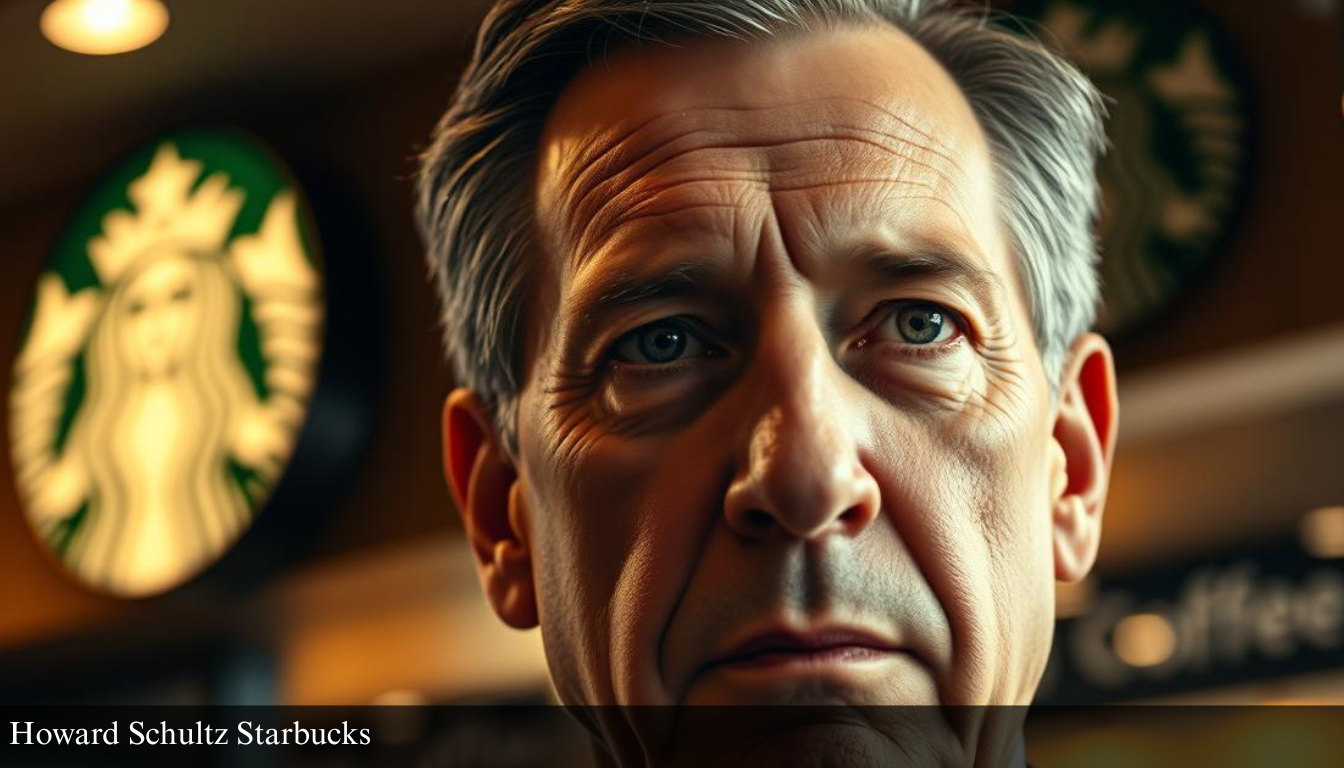
The Birth of Il Giornale Schultz’s First Coffee Venture
The concept of Il Giornale was born out of Schultz’s passion for coffee and his desire to recreate the European coffeehouse experience in America. This venture was not without its challenges, as Schultz faced significant hurdles in securing funding.
Raising $400,000 to Launch His Own Coffee Shop
Schultz needed $400,000 to launch Il Giornale. He faced 242 rejections from investors before securing the necessary funds. As Schultz recalled, “The biggest risk is not taking any risk…”
This quote is often attributed to Mark Zuckerberg, but in the context of Schultz’s story, it reflects his risk taking attitude.
Testing the European Coffeehouse Concept in America
Il Giornale was a test for the European coffeehouse concept in America. Schultz’s vision was to create a “third place

Despite the initial rejections, Schultz’s determination paid off, laying the groundwork for his future success with Starbucks. This experience was a crucial step in the Starbucks success story, demonstrating Schultz’s ability to overcome obstacles and expand his business vision.
FROM RAGS TO RICHES: HOW HOWARD SCHULTZ BUILT THE STARBUCKS EMPIRE
In 1987, Howard Schultz made a bold move by acquiring Starbucks, setting the stage for his rags-to-riches story. This pivotal moment marked the beginning of Schultz’s journey to transform Starbucks into a global coffee giant.
Acquiring Starbucks for $3.8 Million
Schultz’s acquisition of Starbucks for $3.8 million was a significant milestone. It not only gave him control over the company but also provided the opportunity to implement his vision for a coffee shop experience that went beyond just serving coffee.
Creating the “Third Place” Between Home and Work
Schultz envisioned Starbucks as a “third place” between home and work, where customers could relax and enjoy high-quality coffee. This concept became a cornerstone of Starbucks’ success, differentiating it from other coffee shops.
The Strategic Rebranding and Expansion Plan
The strategic rebranding involved redefining the customer experience and expanding the menu to include a variety of coffee blends and food items. Schultz’s expansion plan was aggressive, with a focus on opening new stores across the United States and eventually globally.
Under Schultz’s leadership, Starbucks underwent significant transformations, from its brand identity to its operational strategies. The company’s growth was fueled by a combination of innovative marketing, customer centric policies, and a relentless pursuit of quality.
As Schultz continued to build the Starbucks empire, his rags to riches story became an inspiration to many entrepreneurs. The success of Starbucks under his leadership is a testament to the power of visionary leadership and strategic planning.
Expansion Strategy and Revolutionary Business Philosophy
Under Schultz, Starbucks adopted a revolutionary business philosophy that prioritized employee welfare and controlled growth. This approach not only differentiated Starbucks from its competitors but also played a crucial role in its success.
Employee Centric Policies: Healthcare and Bean Stock
One key part of Schultz’s plan was his care for staff needs. Starbucks was one of the first firms to give full health care to its part, time staff. This act greatly raised staff faith & stay. Also, the Bean Stock plan let staff buy firm stock at a low cost. This tied staff goals with firm wins.
Controlled Growth Without Franchising
Schultz took a slow growth path & did not opt for franchising. By keeping hold of its shops, Starbucks could keep a steady feel for all who came. This plan let the firm keep high levels of quality & help. It helped in making its brand strong.
The Four Pillars of Starbucks’ Success Formula
- Creating a Unique Customer Experience: Schultz focused on making Starbucks stores a welcoming “third place” between home and work.
- Employee Satisfaction: By prioritizing employee welfare through benefits and stock ownership, Schultz ensured that employees were motivated to provide excellent service.
- Innovative Products and Services: Starbucks continuously innovated its menu and services to keep the customer experience fresh and engaging.
- Community Engagement: Schultz emphasized the importance of Starbucks engaging with and contributing to local communities.
These strategies, combined with a commitment to quality and customer service, formed the foundation of Starbucks’ success under Schultz’s leadership.
Navigating Challenges and Corporate Setbacks
In the mid-2000s, Starbucks began to experience market saturation and increased competition. The company’s rapid expansion had led to a decline in customer experience and a loss of the company’s unique culture.
The 2008 Financial Crisis and Market Saturation
The 2008 cash crash hit Starbucks hard. Sales went way down. The brand had to deal with tough fight from other coffee spots & quick food spots with cheap coffee. The market was too full. Too many Starbucks spots took sales from each other.
Schultz’s Return as CEO to Save the Company
In response to these challenges, Howard Schultz returned as CEO in 2008 to revitalize the company. Schultz implemented a series of changes aimed at refocusing Starbucks on its core values and improving customer experience.
The Transformation Agenda and Painful Decisions
Schultz’s big plan had a few parts. Shut down bad stores. Aim at how folks feel in the shop. Show deep care for the best coffee. These shifts did hurt. Many stores had to shut. Some jobs were lost. Yet, these hard picks made Starbucks rise & get back on top.
Under Schultz’s leadership, Starbucks was able to navigate the challenges of the 2008 financial crisis and market saturation, emerging stronger and more resilient than ever.
Innovation and Diversification Under Schultz’s Leadership
Howard Schultz’s strategic vision for Starbucks included a broad range of innovations, from food and music to digital initiatives. Under his leadership, Starbucks transformed into a global brand that offered more than just coffee.
Beyond Coffee: Food, Music, and Digital Initiatives
Schultz saw the chance for Starbucks to be more than just coffee. He brought in food to go with the drinks, like sweets, bread with stuff in it, & green food. Also, Starbucks started to use songs in its shops. This made a warm vibe that made folks want to stay.
The firm made big moves in the web world. Schultz ran the build of the Starbucks app. It let folks buy & pay for their drink ahead. This new thing made things easy for users. It also made work smooth for Starbucks spots.
“We’re not just a coffee company, we’re a gathering place, a third place between home and work.” Howard Schultz
International Market Adaptation Strategies
As Starbucks grew wide, Schultz saw the need to fit with local needs. The firm changed its menu & shop looks to match the likes of each place. For case, in Asia, Starbucks brought drinks & food that fit local tastes. Like matcha lattes & red bean sweets.
The China Expansion and Global Growth
One of the big moves out to other places by Schultz was into China. Starbucks changed its food to fit the taste in China, bringing out things like the “Red Bean Green Tea Crème Frappuccino”. The firm’s wise plan to grow in China was not just to change the food. It was also to make a rare shop feel that fit well with local folk.
Schultz’s leadership and vision played a crucial role in Starbucks’ successful global expansion. By innovating and diversifying the brand’s offerings, Starbucks was able to maintain its competitive edge and continue to grow as a global coffee leader.
Social Impact and Corporate Responsibility Initiatives
Howard Schultz’s vision for Starbucks extends beyond coffee to creating a positive social impact. Under his leadership, the company has implemented several initiatives aimed at enhancing its social and environmental footprint.
College Achievement Plan for Employees
One of the significant initiatives launched by Starbucks is the College Achievement Plan, which provides eligible employees with the opportunity to earn a bachelor’s degree through Arizona State University’s online program. This initiative underscores Schultz’s commitment to investing in employees’ futures.
Environmental Sustainability and Ethical Sourcing
Starbucks has also made considerable efforts in environmental sustainability and ethical sourcing. The company aims to reduce its environmental impact by sourcing coffee beans ethically and promoting recycling and waste reduction in its stores.
Balancing Profit with Social Conscience
As Schultz once said,
“We’re not just a coffee company, we’re a company that cares about the communities we serve.”
This philosophy is reflected in Starbucks’ efforts to balance profitability with social responsibility, demonstrating that business success and social conscience are not mutually exclusive.
Through these initiatives, Starbucks has set a precedent for corporate social responsibility, showing that businesses can drive positive change while achieving financial success.
Life After Starbucks: Political Aspirations and New Ventures
As Schultz transitioned out of his role at Starbucks, he began to explore new avenues for his energy and expertise, including politics and new business ventures.
Stepping Down as CEO and Presidential Considerations
After stepping down as Starbucks CEO in 2017, Schultz considered a run for the presidency, sparking widespread speculation about his political ambitions. Although he ultimately decided against it, his interest in politics remained evident.
Continued Influence in Business and Politics
Schultz continued to be a significant figure in both business and politics, leveraging his experience and reputation to influence various initiatives. His entrepreneurial journey and leadership at Starbucks provided a foundation for his ongoing impact.
The Evolution of Schultz’s Public Persona
As Schultz navigated his post-Starbucks life, his public persona evolved, reflecting his expanding interests and pursuits. He remained a prominent voice in discussions about business expansion and social issues, using his platform to advocate for various causes.
Through his various endeavors, Schultz continued to embody the entrepreneurial spirit that had driven his success at Starbucks, exploring new opportunities and leaving a lasting legacy.
Conclusion: The Lasting Legacy of Howard Schultz
Howard Schultz’s journey from rags to riches is a testament to his unwavering dedication and entrepreneurial spirit. As the driving force behind the Starbucks empire, Schultz transformed a small Seattle coffee shop into a global brand, revolutionizing the way people experience coffee and creating a “third place” between home and work.
Under Schultz, Starbucks stood for top coffee & great service. His work rules, like health care & stock picks, set a high bar for firm care. Schultz’s eye saw past just java. He brought music, food, & web plans that fit with new buyer likes.
The reach of Schultz’s rule goes past the Starbucks realm. His push for good acts & care for our world has led a new age of heads in biz. As proof of his strong mark, Schultz’s tale still moves those who start & lead biz all around the world. It shows the pull of fresh thoughts & strong lead skills.
FAQ
What was Howard Schultz’s background before joining Starbucks?
Howard Schultz grew up in Brooklyn’s housing projects, faced financial struggles, and was influenced by his father’s work injury, which taught him about resilience and determination.
How did Howard Schultz become involved with Starbucks?
Schultz first visited the original Starbucks store in Seattle in 1981, and after a coffee epiphany in Milan, Italy, he joined Starbucks as Director of Marketing.
What was Il Giornale, and how did it relate to Starbucks?
Il Giornale was Schultz’s first independent coffee venture, which later acquired Starbucks in 1987, merging the two concepts under the Starbucks brand.
What is the concept of the “third place” that Howard Schultz created?
The “third place” refers to the welcoming environment Starbucks aimed to create, providing a comfortable spot between home and work for customers to relax and socialize.
How did Howard Schultz expand Starbucks globally?
Schultz implemented a controlled growth strategy without franchising, focusing on company-owned stores, and adapted the Starbucks experience to international markets, including a significant expansion into China.
What employee centric policies did Howard Schultz introduce at Starbucks?
Schultz introduced policies like healthcare benefits and Bean Stock, a stock option plan for employees, to foster a positive work environment and encourage employee loyalty.
How did Howard Schultz handle challenges during his tenure at Starbucks?
Schultz navigated challenges, including the 2008 financial crisis, by returning as CEO, implementing a transformation agenda, and making strategic decisions to revitalize the company.
What initiatives has Starbucks undertaken under Howard Schultz’s leadership to promote social responsibility?
Under Schultz, Starbucks implemented initiatives like the College Achievement Plan for employees, environmental sustainability efforts, and ethical sourcing practices to balance profit with social conscience.
What has Howard Schultz done since stepping down as CEO of Starbucks?
Schultz has considered a presidential run, continued to influence business and politics, and evolved his public persona, remaining a significant figure in both realms.
Conclusion Writing Your Howard Schultz
Howard Schultz’s story is more than a tale of building Starbucks into a global empire. It’s a reminder that vision, persistence, and the courage to dream big can turn humble beginnings into lasting success.
Your own journey may not involve coffee, but the principles remain the same: believe in your idea, stay committed when challenges arise, and never lose sight of the bigger picture.
If you’d like to explore more about his life and achievements, you can find detailed information on Wikipedia. And if you want guidance to shape your own career path or business journey, Careerizo offers tools, insights, and motivation to help you write your success story.

